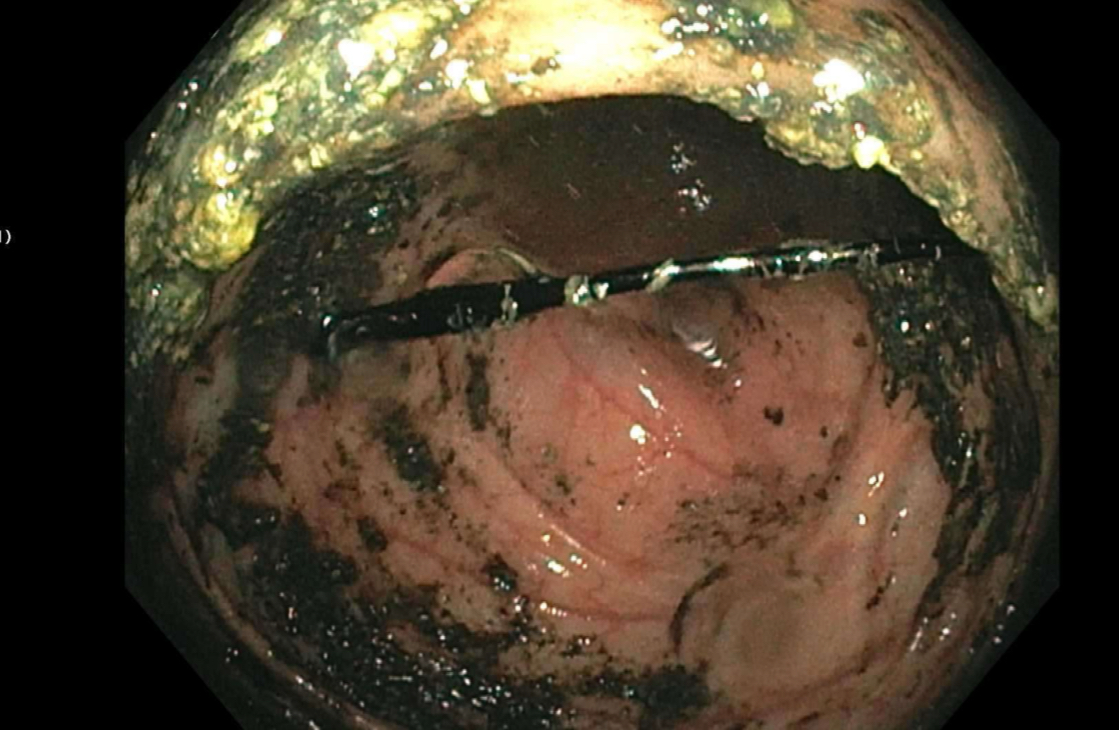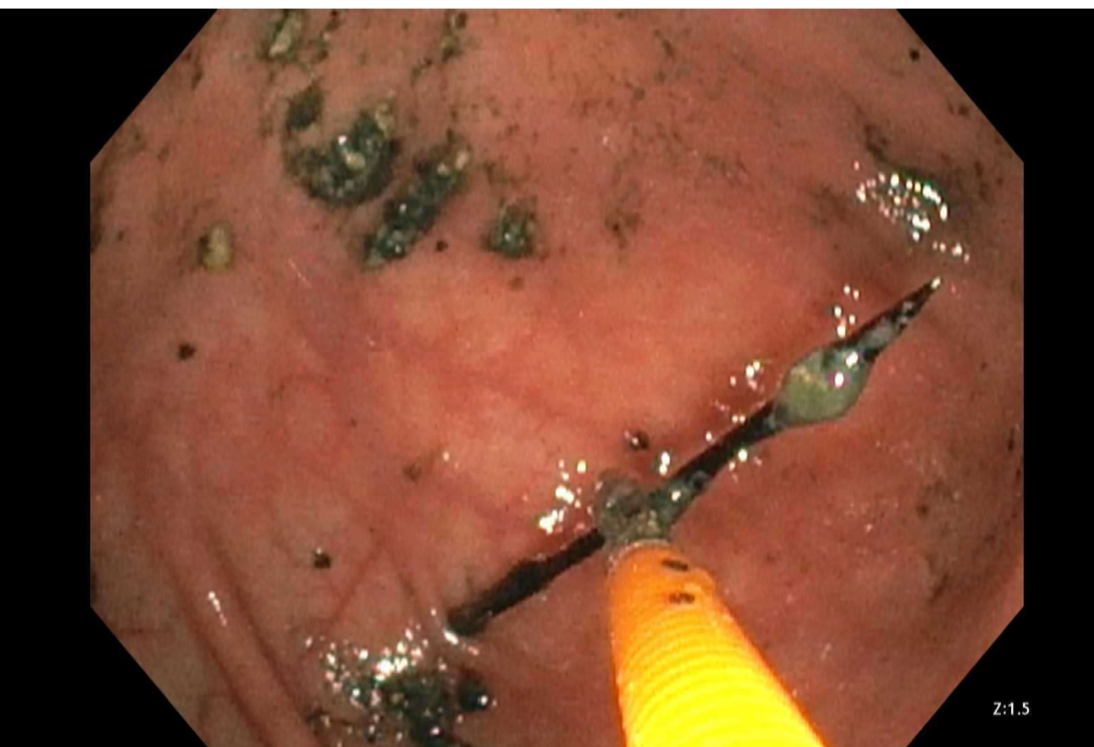Sunday Poster Session
Category: Pediatrics
P1903 - When Sharp Objects Stall: Pediatric Colonoscopic Management of a Retained Sewing Needle
Sunday, October 26, 2025
3:30 PM - 7:00 PM PDT
Location: Exhibit Hall
- SH
Shahab ul Huddah, MBBS (she/her/hers)
Saint Louis University
St. Louis, MO
Presenting Author(s)
Julia Esswein, MD1, Shahab ul Huddah, MBBS1, Rahiya Rehman, MD2
1Saint Louis University, St. Louis, MO; 2Saint Louis University, Saint Louis, MO
Introduction: While most ingested foreign bodies in the colon are managed conservatively due to their likelihood of spontaneous passage, there is limited published literature on colonoscopic retrieval techniques of sharp or elongated objects in pediatric patients. We present a case demonstrating a successful colonoscopic retrieval of a needle using pediatric biopsy forceps and a foreign body retrieval hood.
Case Description/
Methods: A 15-year-old female presented to the emergency department following accidental ingestion of a sewing needle at home. She was hemodynamically stable, and physical examination was unremarkable. An initial abdominal X-ray revealed a sharp needle beyond the ligament of Treitz. The patient was admitted for observation and managed conservatively with a bowel regimen given large stool burden. Serial abdominal radiographs initially suggested that the object was progressing through the gastrointestinal tract. By hospital day 4, the needle had reached the hepatic flexure, but then showed no further advancement on X-ray obtained on the subsequent day. The patient began to experience abdominal discomfort, though there were no peritoneal signs on exam. Given the stagnation of the object and the potential risk for mucosal injury or perforation, a multidisciplinary decision was made to proceed with colonoscopy with foreign body removal. On colonoscopy, the needle was seen lodged at the hepatic flexure, with its sharp end embedded behind a mucosal fold. Using standard pediatric biopsy forceps the needle was carefully grasped and retrieved by using foreign body retrieval hood without causing mucosal injury.
Post-procedure, the patient was observed for 24 hours. A follow-up abdominal X-ray showed no evidence of perforation or free air. She tolerated a regular diet and was discharged the following day in stable condition.
Discussion: There is limited literature regarding the management of sharp foreign bodies retained in the colon in pediatric patients. The duration of conservative management with serial imaging in asymptomatic cases remains undefined. Anatomical regions prone to impaction include the ileocecal valve, appendiceal orifice, and colonic flexures, and may result in mucosal trauma, perforation, peritonitis, or fistula formation if not promptly addressed. Use of standard biopsy forceps with a foreign body retrieval appears a safe method for the retrieval of sewing needles.

Figure: Sewing needle at the right hepatic flexure

Figure: Sewing needle grasped with biopsy forceps
Disclosures:
Julia Esswein indicated no relevant financial relationships.
Shahab ul Huddah indicated no relevant financial relationships.
Rahiya Rehman indicated no relevant financial relationships.
Julia Esswein, MD1, Shahab ul Huddah, MBBS1, Rahiya Rehman, MD2. P1903 - When Sharp Objects Stall: Pediatric Colonoscopic Management of a Retained Sewing Needle, ACG 2025 Annual Scientific Meeting Abstracts. Phoenix, AZ: American College of Gastroenterology.
1Saint Louis University, St. Louis, MO; 2Saint Louis University, Saint Louis, MO
Introduction: While most ingested foreign bodies in the colon are managed conservatively due to their likelihood of spontaneous passage, there is limited published literature on colonoscopic retrieval techniques of sharp or elongated objects in pediatric patients. We present a case demonstrating a successful colonoscopic retrieval of a needle using pediatric biopsy forceps and a foreign body retrieval hood.
Case Description/
Methods: A 15-year-old female presented to the emergency department following accidental ingestion of a sewing needle at home. She was hemodynamically stable, and physical examination was unremarkable. An initial abdominal X-ray revealed a sharp needle beyond the ligament of Treitz. The patient was admitted for observation and managed conservatively with a bowel regimen given large stool burden. Serial abdominal radiographs initially suggested that the object was progressing through the gastrointestinal tract. By hospital day 4, the needle had reached the hepatic flexure, but then showed no further advancement on X-ray obtained on the subsequent day. The patient began to experience abdominal discomfort, though there were no peritoneal signs on exam. Given the stagnation of the object and the potential risk for mucosal injury or perforation, a multidisciplinary decision was made to proceed with colonoscopy with foreign body removal. On colonoscopy, the needle was seen lodged at the hepatic flexure, with its sharp end embedded behind a mucosal fold. Using standard pediatric biopsy forceps the needle was carefully grasped and retrieved by using foreign body retrieval hood without causing mucosal injury.
Post-procedure, the patient was observed for 24 hours. A follow-up abdominal X-ray showed no evidence of perforation or free air. She tolerated a regular diet and was discharged the following day in stable condition.
Discussion: There is limited literature regarding the management of sharp foreign bodies retained in the colon in pediatric patients. The duration of conservative management with serial imaging in asymptomatic cases remains undefined. Anatomical regions prone to impaction include the ileocecal valve, appendiceal orifice, and colonic flexures, and may result in mucosal trauma, perforation, peritonitis, or fistula formation if not promptly addressed. Use of standard biopsy forceps with a foreign body retrieval appears a safe method for the retrieval of sewing needles.

Figure: Sewing needle at the right hepatic flexure

Figure: Sewing needle grasped with biopsy forceps
Disclosures:
Julia Esswein indicated no relevant financial relationships.
Shahab ul Huddah indicated no relevant financial relationships.
Rahiya Rehman indicated no relevant financial relationships.
Julia Esswein, MD1, Shahab ul Huddah, MBBS1, Rahiya Rehman, MD2. P1903 - When Sharp Objects Stall: Pediatric Colonoscopic Management of a Retained Sewing Needle, ACG 2025 Annual Scientific Meeting Abstracts. Phoenix, AZ: American College of Gastroenterology.
